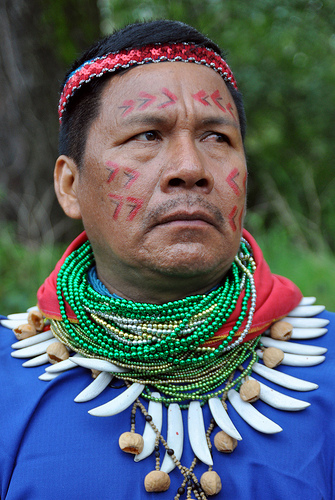
This past week, Emergildo Criollo, an Indigenous Ecuador leader of the Cofan people traveled 3,000 miles from his home in the Amazon rainforest to California. He came to California to share his story and ask for support in getting one of the world’s largest oil companies (Chevron) to clean up one of the largest environmental disasters in history.
For a whirlwind few days this week, Emergildo shared his story with Chevron employees, California Senators and Assemblymembers, journalists, activists, and Chevron’s new CEO John Watson’s Lafayette neighbors.
Here is the story that Emergildo told (translated from Spanish):
“I want to start telling my story from when I was a child.
In 1964, I was 6 and living by the river.
As was the tradition of my people we would migrate from area to area to hunt. We were in (what is now called Lago Agrio) hunting.
At one point we heard this really loud noise coming from the sky. We thought it was a large bird (it was a helicopter). We were scared and hid.
The helicopter landed and we were very scared. They landed and started cutting down trees. They cut down about 10 hectares of trees.
Texaco (now Chevron) set up a worker camp. Me and my father tried to sell our jewelry. I was wearing my traditional dress. The workers came up and lifted my dress. I was so embarrassed. They lifted it because they didn’t know if I was a little girl or boy. It was so humiliating.
A few months passed and we saw great waves of oil floating down the river. We had to part the sheets of oil to get the water. As we walked we waded through oil. We tried to get it off our skin but we couldn’t get clean.
After a bit we said we can’t live here anymore and we had to relocate.
About a decade passed. I met my wife. She got pregnant and was drinking water that we didn’t know was contaminated. My son was born but didn’t grow well. He died at just 6 months. I took him to a hospital in Quito but they couldn’t do anything.
Then our second son was born. I would take him to the river to swim. One day at the river he drank the water and started vomiting and vomiting. He soon started vomiting blood. Within 24 hours, he was dead too.
After seeing this I realized we couldn’t drink from the river. We started digging wells and looking for subterranean water which we hoped was cleaner.
After being exposed my wife became ill. She had uterine cancer and had to have a hysterectomy. She was never the same after. Always in pain.
It wasn’t just my family that was affected by the polluted water. And not just my people, the Cofan, but all the other Indigenous communities and campesinos in the area. Many, many of our brothers and sisters have died as well.
Before Texaco (now Chevron) arrived we lived well. We had plenty of food. Plenty of animals and plenty of medicinal plants. Everything has changed. All of our customs have been transformed since the company’s arrival.
If you can imagine, we have lost our traditional healers and medicine with Texaco’ (now Chevron) arrival. The irony is we now have so many new illnesses and we have lost our abilities to heal.
There were changes for the women as well. The women would traditionally get firewood by the river. Because of oil spills, the wood was drenched in thick, black oil. The oil coated their bodies and polluted the food they cooked over the wood.
The women suffered as well. The Cofan women never had miscarriages before. With Texaco (now Chevron) and the contamination there were suddenly many miscarriages and children born with abnormalities. There has been so much pain for our women.
This continues today. People are dying of cancer and oil-related illness. They just left so many open oil pits and never cleaned up. This is why we started the lawsuit.
That’s what our lawsuit is about. To get Chevron to take responsibility. They need to see the supposed clean-up was not a proper clean-up. They just sprinkled dirt on the oil pits, covered them up. But if you dig even 50 cm it is thick with oil. This is not a proper clean up. The oil is still there.”
These open waste pits had no protective liner. The oil would seep into the the ground, and then into the smaller rivers, and the larger rivers. The contamination affects so many people.”
Emergildo’s story is the story of thousands of people in the region. What will it take for Chevron to do the right thing, clean up Ecuador, and put an end to the suffering?